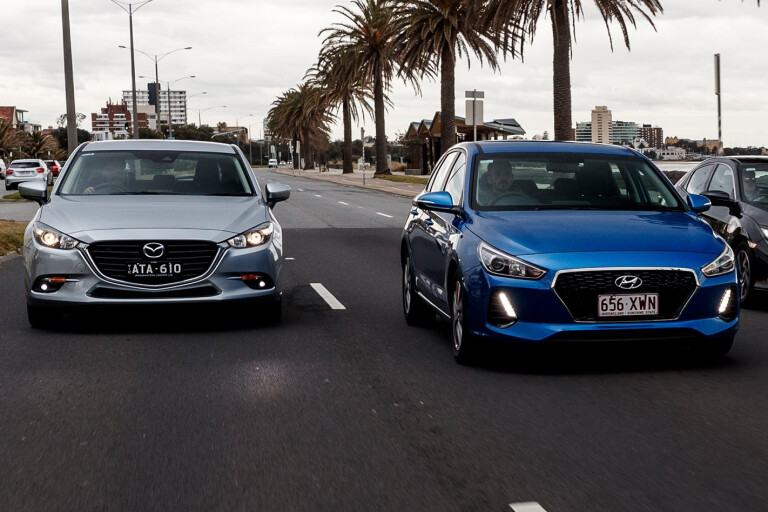
Since its was first introduced in 2013, the current generation Mazda 3 has been considered the benchmark of the small-car class, with a series of subtle style tweaks and technical upgrades.
This has helped it maintain second place on the passenger car sales ladder behind the ubiquitous Toyota Corolla, though its biggest rival is arguably the Hyundai i30 that continues to threaten its market share thanks to its fresher aesthetics, and driver engagement.
With the next-generation Mazda 3 on the horizon we decided to revisit the current model in mid-spec Touring hatchback automatic guise to see how it stands up against the relatively youthful Hyundai i30 Active auto.
VALUE
Mazda 3
The Mazda 3 Touring is the plushest of the 2.0-litre versions, with retail pricing starting at $25,490 for the six-speed manual, with the six-speed auto attracting a $2000 premium. The sedan and hatch versions cost the same.
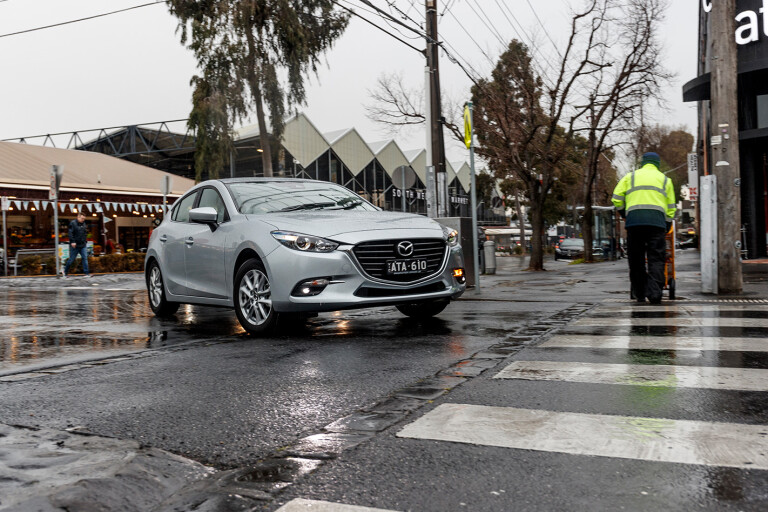
The Touring costs just $4000 more than the entry-level Neo Sport and $10,000 less than the range-topping SP25 Astina.
The 2.0-litre engine is reasonably frugal, with an official combined fuel consumption figure of 5.8L/100kms when coupled to the optional six-speed auto. Our real-world driving saw that figure rise to 8.5L/100km, though this involved quite a lot of city driving, mostly in Sport driving mode.
The Mazda 3 Touring requires servicing every 10,000kms or 12 months, whichever comes first, which is relatively frequent. Mazda charges $303 for the first and third service appointments and $331 for the second and fourth.
Hyundai i30
Priced at $23,390, the i30 Active 2.0-litre petrol automatic we’re testing here costs $2300 more than the manual version. The same grade can also be had with a 1.6-litre turbo diesel version in manual or automatic form, for $23,590 and $26,090 respectively, if you’re looking for a more fuel-efficient option.
However, if you’re looking for the most affordable i30 outright, there’s another variant below the Active called the i30 Go that starts at $19,990 for the manual, or $22,290. If feature-count matters not, then the Go is the one for bargain-hunters.

The vehicle we tested was standard, with the only extra on top of the six-speed automatic gearbox being the Marina Blue paintwork for an extra $495 that took the total retail price to $23,885.
The 2.0-litre engine’s claimed average fuel consumption is 7.4L/100km with the automatic, which is a little thirsty for a small hatch – the similarly powered Mazda 3, for example, sips unleaded at a rate of 5.8L/100km.
As for servicing, the i30 tested here has 12-month/15,000km service intervals. Scheduled services within the first five years are capped at $259 a visit, except for the 45,000km major service which will cost you $359. The i30 is covered by Hyundai’s five-year/unlimited kilometre warranty.
STANDARD FEATURES
Mazda 3
The Touring adds a few creature comforts over the Maxx Sport including leather upholstery, automatic folding mirrors and advanced keyless entry that lets you open the door and start the engine without having to take the key fob out of your bag or pocket.

That’s on top of a healthy equipment list that includes a 7.0-inch colour screen, AM/FM/Digital (DAB+) radio, and autonomous emergency braking that also works in reverse to help prevent parking bingles.
Other features include rear-parking sensors, cruise control, blind-spot monitoring, rear-cross traffic alert, dual-zone climate control, dusk-sensing headlights, LED fog-lamps, rain-sensing windscreen wipers, an electric park brake and 16-inch alloy wheels.
Hyundai i30
You’ll find things in the i30 Active that are options in far more expensive cars, such Apple CarPlay and Android Auto smartphone pairing, satellite navigation and digital radio (DAB+), which are controlled via an 8.0-inch touchscreen.
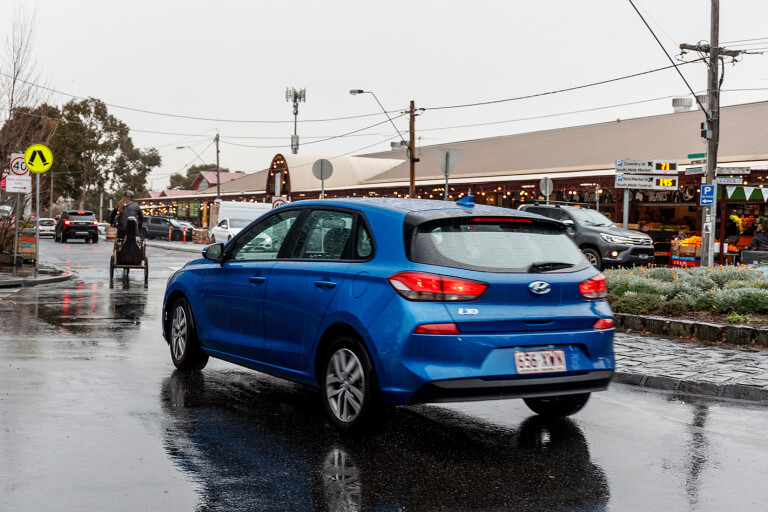
It also comes with LED daytime running lights, power-folding electric mirrors, cloth seats and cruise control. 16-inch alloy wheels are standard, and you get a full-sized spare alloy wheel as well – something that’s often a cost option in this segment, or replaced by a space-saver.
SIZE
Mazda 3
The Mazda 3 Touring we tested is a five-door hatchback that seats up to five people. A four-door sedan with five-person capacity is also available..
Measuring 4.47m long by 1.79m wide, and weighing in at 1308kg, the Mazda 3 Touring hatch auto isn’t the smallest car in its class, however boot space is tight with a 308-litre capacity that measures less than smaller cars such as the Kia Rio and Hyundai Accent. The Mazda 3 sedan’s boot holds a more sizable 408 litres.
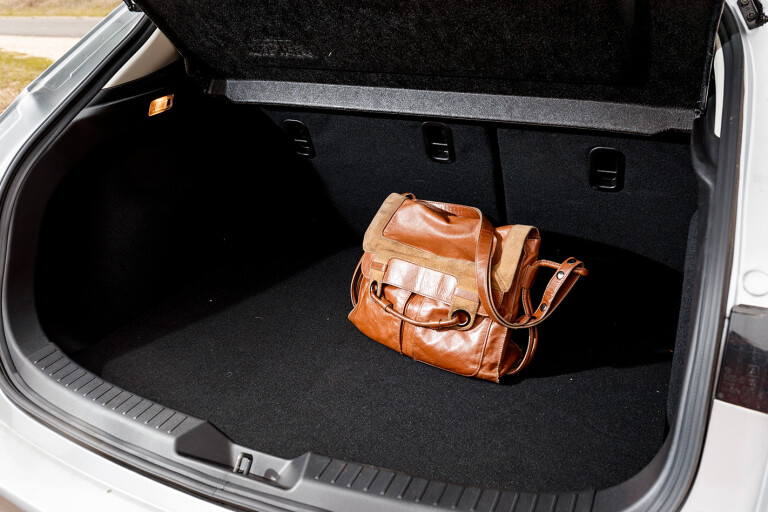
Hyundai i30
The Hyundai i30 Active is a five-door hatchback that seats up to five people.
It measures just 4.34m length with a 2650 wheelbase that accommodates a spacious interior and practical 395-litre boot space that expands to 1301 litres with the rear 60:40-split seatbacks folded down.
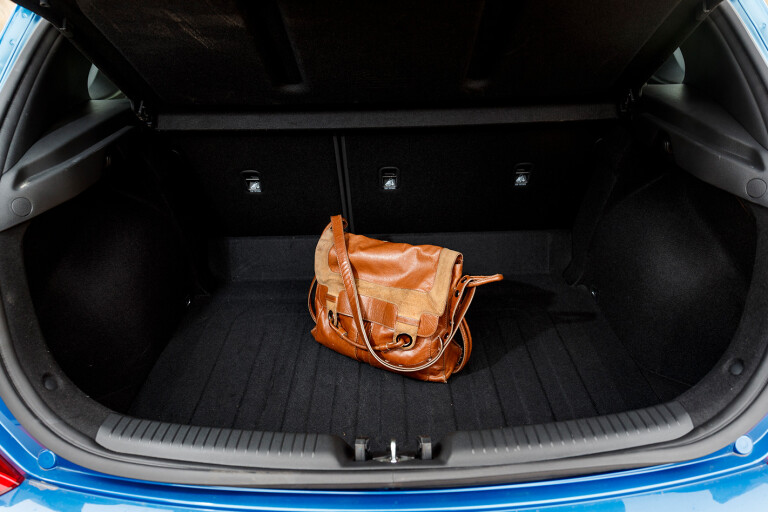
SAFETY
Mazda 3
The Mazda 3 received a five-star ANCAP safety rating in August 2016 thanks in part to its active safety features, including range-wide autonomous emergency braking (AEB). It scored well for crash protection, including 16 out of 16 for side impact. It has six airbags, and child-seat anchor points including two ISOFIX brackets for each outboard rear seat, and three top tethers.
The Touring brings additional active safety over and above the standard kit, including blind-spot monitoring and rear-cross traffic alert that warns you of any cars approaching from the side while you reverse.
Hyundai i30
The Hyundai i30 was awarded a five-star ANCAP rating in April 2017. It’s a safe car in terms of crash protection, with seven airbags including a driver’s knee bag and full-length curtain airbags to protect your head.
Other safety features include a reversing camera, rear parking sensors, auto-on headlights, LED daytime running lights, seatbelt reminders on front and rear seats, and electronic stability control that all cars are required to have.

Active safety features including autonomous emergency braking aren’t included on the standard spec sheet, however it available as part of Hyundai’s SmartSense package that for around $1700 adds active cruise control, auto-braking, lane keeping assist, driver attention alert, blind-spot detection, and rear-cross traffic alert.
COMFORT
Mazda 3
The Mazda 3’s interior is showing its age, but still has an air of sophistication with soft-touch surfaces aplenty, clean design, a leather-clad steering wheel and intelligently-placed switches and gauges. The seats, trimmed with a mix of real and faux leather, offer good comfort. The driver’s seat has height and lumbar adjustment to help you settle into a good driving position.

The MZD infotainment system is easy to operate via a dial on the centre console. It lacks the added convenience of Apple CarPlay and Android Auto smartphone mirroring, however an upcoming update will allow that tech to be retrofitted next year.
The Mazda 3 loses marks in the back row, with its ascending window line obscuring side vision for younger occupants. Legroom is a little tight as well, with even average-sized adults finding their shins touching the front seats.
Second-row passengers also miss out on conveniences such as face-level air vents, and there are no USB or 12v charging sockets to keep devices charged up. It might be a niggling complaint, but those features are fast becoming common in newer cars in the segment. There are at least bottle holders in the doors and the fold-down centre armrest has two cup holders, though there’s only one map pocket on the passenger side.
Road noise is also high despite Mazda attempting to improve sound suppression in a 2016 update, but the ride is comfortable even on rougher roads thanks to a settled ride that recovers quickly from big hits.
Hyundai i30
The i30 Active’s cloth seats are comfortable and there’s good leg and headroom throughout, though the rear seat is a little too narrow to comfortably seat three adults – though that’s common for this segment.
The smaller 16-inch wheels provide it with a better ride than the up-spec models that roll on 17s and 18s, and the locally-tuned suspension has a composed ride over bumps.
The conservative cabin design is a little bland and hard plastics abound, but the dashboard looks neat and uncluttered and the controls, particularly the switches on the steering wheel, are intuitively laid out.
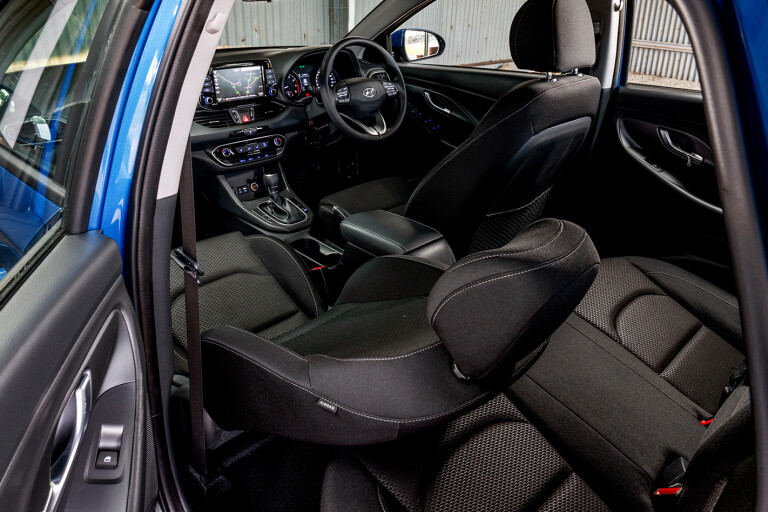
The 8.0-inch touchscreen, which is a staple across the Hyundai and Kia range, looks good, works well and the infotainment system is very easy to navigate.
Rear-seat passengers miss out on their own air vents or USB/12v charging sockets, but if their phones go flat they can enjoy the view with good side and forward vision through the i30’s generous glasshouse.
ON THE ROAD
Mazda 3
The 2.0-litre engine is a city slicker but has enough power for easy trips down the highway, with the six-speed automatic transmission working smoothly with throttle inputs.
It is, however, a little lethargic from a standing start and doesn’t really wake up until the tachometer hits about 4000rpm. A Sport drive mode introduced in 2016 makes the engine rev higher before shifting up to the next gear, though frequent use of that feature will see your fuel consumption head north.
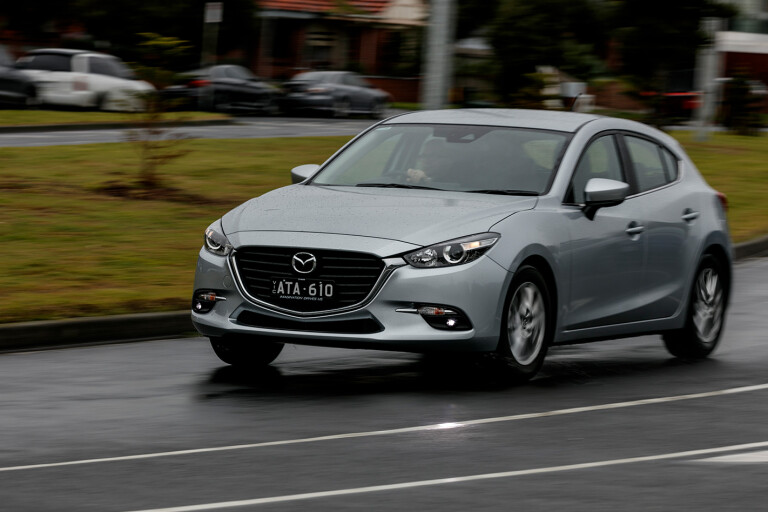
The Mazda 3 is an enjoyable car to drive, with light but engaging steering that makes easy work of negotiating suburban streets and bendy country roads. Despite its age it remains one of the segment’s best when it comes to handling.
The ride feels soft but delivers enough body control for sharp cornering. This is helped by something that Mazda calls G-Vectoring Control, which subtly trims power when cornering to transfer load onto the front tyres and help them produce more cornering grip. Result: the car feels more planted while changing direction more fluidly, but you’ll barely notice that the electronics are giving you a helping hand.
Hyundai i30
While it’s not intended to be as spirited or dynamic as the sportier i30 SR at the upper end of the range, the Active certainly feels nimble enough around town. Hyundai has honed its chassis and suspension for Aussie roads resulting in a great ride and body control on a broad range of road surfaces, which makes it feel like a bigger, more mature car.
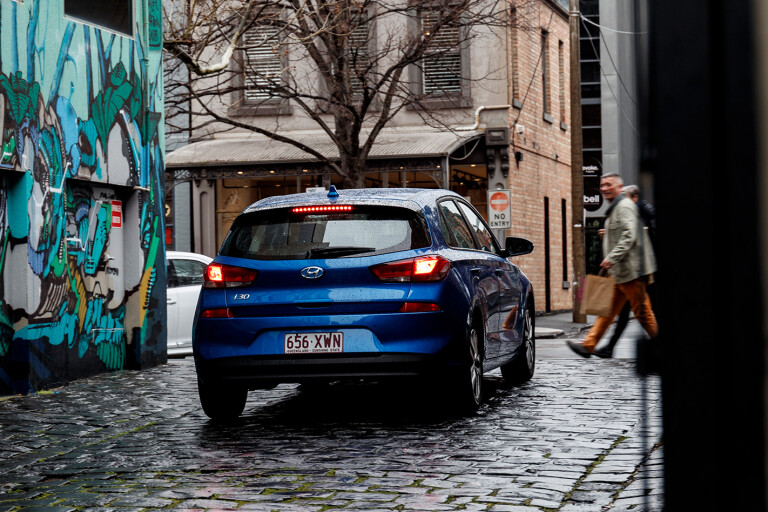
Meanwhile, the 120kW/203Nm 2.0-litre petrol engine responds quickly to throttle inputs and the six-speed torque converter automatic gearbox shuffles smoothly between steps. It may be a comparatively thirsty engine, but it also produces more power than many others at its price point. For those that don’t like to dawdle, that’s worth noting.
OUR OPINION
The Mazda 3 is less than a year away from being replaced by an advanced next-generation model, but will bow out like a champion cricketer who scores a ton in their final Test match.
It’s significantly older than the Hyundai i30, but the age difference is less noticeable at the lower end of their respective ranges, where the Mazda’s trim and equipment levels exceed the i30 Active, which doesn’t benefit from the standard active safety, plush interior and sharper driving dynamics found higher up the range.
Adding the SmartSense active safety to the i30 Active brings its price and safety levels on a par with the Mazda 3 Touring, but the Mazda still has enough going for it in terms of sophistication to give it the slight edge.
COMMENTS